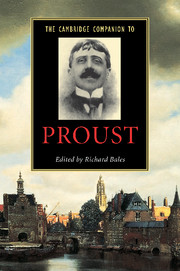Book contents
- Frontmatter
- Introduction
- 1 From Belle Epoque to First World War
- 2 The vast structure of recollection
- 3 Ruskin and the cathedral of lost souls
- 4 The birth and development of A la recherche du temps perdu
- 5 Lost and found: the structure of Proust’s novel
- 6 Proust’s Narrator
- 7 The unconscious
- 8 The texture of Proust’s novel
- 9 Proust’s human comedy
- 10 Proust and social spaces
- 11 Love, sexuality and friendship
- 12 Proust and the fine arts
- 13 Proust and posterity
- Postlude
- Select bibliography
- Index
4 - The birth and development of A la recherche du temps perdu
Published online by Cambridge University Press: 28 May 2006
- Frontmatter
- Introduction
- 1 From Belle Epoque to First World War
- 2 The vast structure of recollection
- 3 Ruskin and the cathedral of lost souls
- 4 The birth and development of A la recherche du temps perdu
- 5 Lost and found: the structure of Proust’s novel
- 6 Proust’s Narrator
- 7 The unconscious
- 8 The texture of Proust’s novel
- 9 Proust’s human comedy
- 10 Proust and social spaces
- 11 Love, sexuality and friendship
- 12 Proust and the fine arts
- 13 Proust and posterity
- Postlude
- Select bibliography
- Index
Summary
Of the many areas of Proust scholarship, the one that has probably most enriched our knowledge of A la recherche du temps perdu consists of the wealth of genetic and textual studies on the novel carried out over the past thirty years. It now seems generally agreed that the long history of the novel's conception, elaboration and publication is not only fascinating and rewarding in its own right, but also enlightens our understanding and appreciation of Proust's work, giving a glimpse into the mind of one of the great masters of modern writing. In this chapter, I will outline the various compositional stages the novel underwent in the fourteen years of its development between January 1908, when Proust began to jot down ideas for a new fictional project, and November 1922, when - already terminally ill - he envisaged a highly controversial reorganisation of the novel's penultimate volume, Albertine disparue.
From ‘Contre Sainte-Beuve’ to the novel of remembrance (1908–1909)
The year 1908 is generally considered as the starting point for the Recherche. Proust is thirty-six years old and virtually unknown as a writer. He has published a collection of short stories, portraits and poems, Les Plaisirs et les jours (1896), two annotated translations of Ruskin, La Bible d’Amiens (1904) and Sésame et les lys (1906), as well as a series of articles and reviews, but has produced no fiction since 1899, when he abandoned his novel Jean Santeuil. We do not know precisely what made him return to novelistic writing in the early months of 1908.
- Type
- Chapter
- Information
- The Cambridge Companion to Proust , pp. 58 - 73Publisher: Cambridge University PressPrint publication year: 2001
- 4
- Cited by



